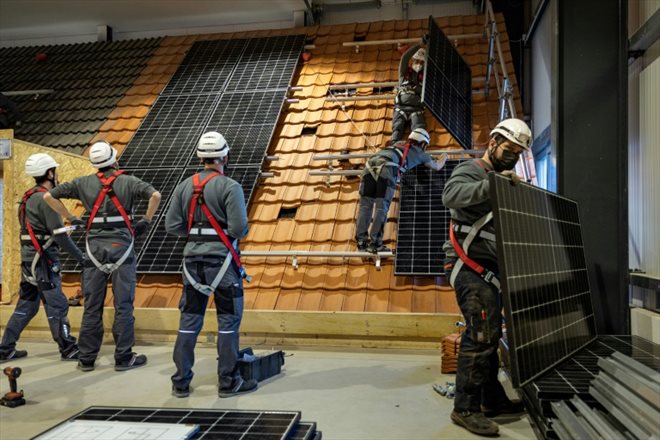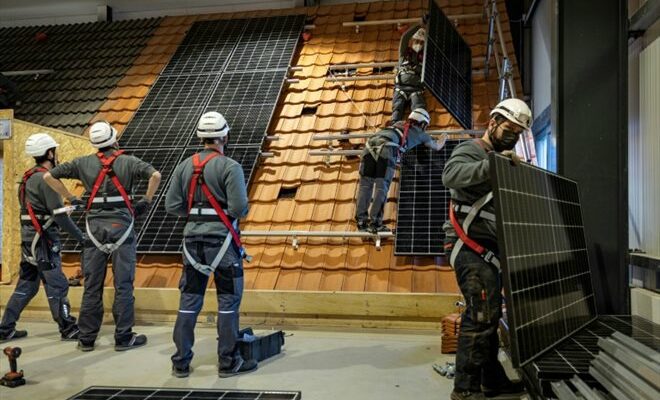Enpal employees practice installing solar panels at the company’s training center in Blankenfelde, south of Berlin, on February 15, 2023 (AFP/Odd ANDERSEN)
Balancing on the slope of the roof, the apprentice fixes the solar panel, under the satisfied eye of his trainer: Pascal Ode will soon be ready to strengthen the German photovoltaic industry which is sorely lacking in manpower.
It was on Instagram that the 19-year-old saw the ad offering to be trained in four weeks in the installation of solar panels.
The desire to learn “something new”, the attraction of “work in the great outdoors” convinced him to join this construction site-school in the suburbs of Berlin, he told AFP.
The hangar resounds with the sound of drills and screwdrivers, manipulated by clusters of helmeted and strapped-on apprentices, training on replicas of roofs placed on the ground.
An effervescence in the image of the boom experienced by the solar sector in a Germany thirsty for renewable energies to succeed in its transition and replace Russian gas.
Photovoltaic power installed in the residential sector increased by 40% last year compared to 2021.
“Since the Russian invasion of Ukraine, many people want to emancipate themselves from fossil fuels and high energy costs,” says Wolfgang Gründinger, spokesman for Enpal, one of the many young companies surfing on this tendency.
– Reconverted delivery men –

Enpal employees practice installing solar panels at the company’s training center in Blankenfelde, south of Berlin, on February 15, 2023 (AFP/Odd ANDERSEN)
The Berlin start-up offers solar panels for long-term rental, which its teams install and maintain. Created in 2017, Enpal says it has sold 40,000 subscriptions, including 18,000 last year alone, and is currently running at the rate of 2,000 installed kits per month.
“We have to install a lot of units as quickly as possible, while we are experiencing a very serious shortage of qualified workers”, observes Alexander Friedrich, one of the instructors hired by the company.
Enpal partially solved the problem by creating its own training school for specialist fitters and electricians last year, based in Blankenfelde, south of Berlin. It is the one that Pascal Ode joined at the start of the year.
“We recruit people from all walks of life, former pizza makers, cooks, meal deliverers, taxi drivers…”, lists Mr. Gründinger. The school trains up to 120 new employees per month.
But the needs are immense: Germany wants 80% of gross electricity consumption to be covered by renewable energies by 2030, compared to 46% last year. The law has set the objective of installing 215 gigawatts (GW) of photovoltaic power by this deadline, implying that the annual development will be multiplied by three (7.2 GW installed in 2022).
Solar installations must flourish on the roofs of factories, commercial buildings, in fields, according to government projects.
But “the shortage of skilled workers threatens to slow down the energy transition” in Europe’s largest economy, warns the German Economic Institute (IW), one of the most renowned in the country, in a recent report.
– Chinese dependency –

Employees train in the installation of solar panels on roofs, at the premises of the Enpal company, in Blankenfelde-Mahlow (Germany), on February 15, 2023 (AFP / Odd ANDERSEN)
So much so that the federation of solar industries BSW says it is counting on the major migration reform prepared for this summer by the government of Olaf Scholz to meet its labor needs.
“We will develop the integration of foreigners in the solar sector after the entry into force of the new law on the immigration of skilled workers”, indicates to AFP its president Carsten Körnig.
The federation cites as an example a recent agreement which aims to send Indian workers trained in photovoltaics to Germany.
Electricians, heating and air conditioning experts, computer scientists, there is currently a shortage of around 216,000 skilled workers to develop solar and wind energy, according to the IW Institute.
Not to mention the needs to set up a production chain for solar panels, while the overwhelming majority of components (polysilicon, wafers, cells) arrive from China, posing a problem of sovereignty for Europeans.
Until the 2010s, however, Germany had several world leaders in the production of photovoltaic cells.
The reduction of public aid and the rise of Chinese competition have strangled these manufacturers, leading to the loss of some 100,000 jobs in the sector, according to the union IG Metall.
The drop in cell manufacturing costs and the increase in demand could however revive this industry, like the new factory inaugurated in 2021 by the Swiss group Meyer Burger, between Berlin and Leipzig, on the site of a former photovoltaic company that went bankrupt ten years ago.
© 2023 AFP
Did you like this article ? Share it with your friends with the buttons below.




